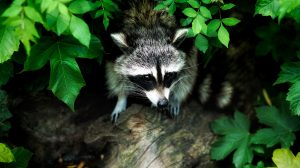 An adult raccoon is a stocky mammal about 2 to 3 feet long and weighs 7 to 30 pounds. Raccoons are distinctively marked with a black mask over the eyes and has heavy fur with alternating dark and light rings around its tail.
An adult raccoon is a stocky mammal about 2 to 3 feet long and weighs 7 to 30 pounds. Raccoons are distinctively marked with a black mask over the eyes and has heavy fur with alternating dark and light rings around its tail.
Raccoons are active all year but may take cover in dens during periods on severe winter weather.
Wooded areas near water and natural habitats are preferred. They typically create dens in hollow trees, brush piles, rock crevices and ground burrows. These animal are nocturnal and adapt well to urban backyards beneath porches, decks, and sheds. Raccoons are known to create dens in attics, chimneys and spaces beneath houses. Since they are primarily active at night, raccoons are often present and can go undetected for an extended period of time.
Damage
Common problems happen when raccoons search for nesting sites in buildings. Females seeking a nesting site will rip off fascia boards, roof shingles and rooftop ventilators to get access to the attic. Once inside, the animal may tear up or displace insulation and heating and air conditioning duct insulation may be ripped off.
Raccoons may use an area of the attic as a latrine. The ceiling beneath this area may become stained with urine and accompanied by an objectionable odor. Ectoparasites may infest the attic and migrate to other parts of the house.
Disease
Raccoons are known to carry internal parasites and a number of diseases. The raccoon roundworm, an infection spread to people by the accidental ingestion or inhalation of roundworm eggs from raccoon feces, has caused concern in recent years. Roundworm infection can cause serious disabilities and young children are thought to be the most susceptible. Raccoons are carriers of distemper and rabies. Pets should be properly vaccinated to mitigate this threat.
Exclusion
Exclusion is the key to eliminating den sites but raccoons are powerful animals and can become vicious when cornered. Their front paws are handlike, with long, flexible toes and considerably dexterous. Raccoons have been known to unhook simple latches.
Prevent access to chimneys by covering them with a spark arrester that meets the fire code in your area. These caps can keep out raccoons, tree squirrels, rats and birds. The arrester should be secured tightly to the chimney to keep raccoons from pulling them off. Make sure no animals are inside the chimney prior to covering the opening. If raccoons are nesting in your chimney and present, hiring a professional is often the effective option for removing them.
Open spaces beneath structures, such as decks, porches and sheds should be tightly screened with 10-gauge 1/4 or 1/3 inch galvanized hardware mesh. The bottom edge of the wire should be buried at least 6 inches deep and extending 12 inches outward – then covered by soil. These measures will not only exclude raccoons but also skunks, opossums, squirrels and rats.
Frightening Away
A variety of materials, devices and gadgets have been designed to frighten raccoons and other wildlife. These include flashing lights, sound-producing devices and water-squirting units – all of which can be activated by motion detectors. Radios, scarecrows, flags and windmills that spin and flutter in the wind have been used. These devices can be effective for a few days. However, raccoons often quickly learn that there is no threat associated with these devices and they will cease to be effective.
Trapping
It’s advisable to hire a professional wildlife control company if you have raccoons. These professionals have the proper equipment and can discern whether a trapped female is nursing young. It’s important to not leave the young behind to starve.
For additional information and photos, use Google Search.
Search for topics raccoon, raccoons, raccoons California.